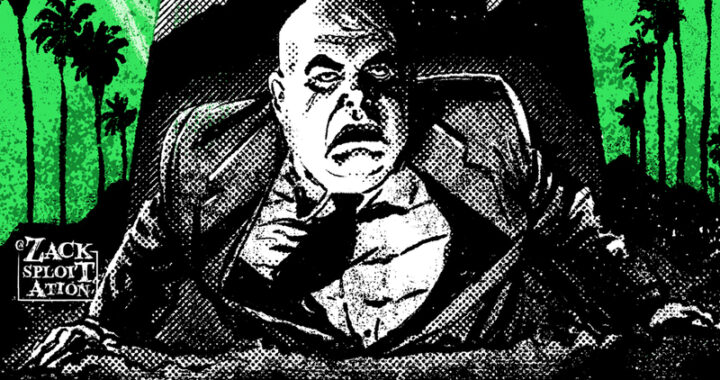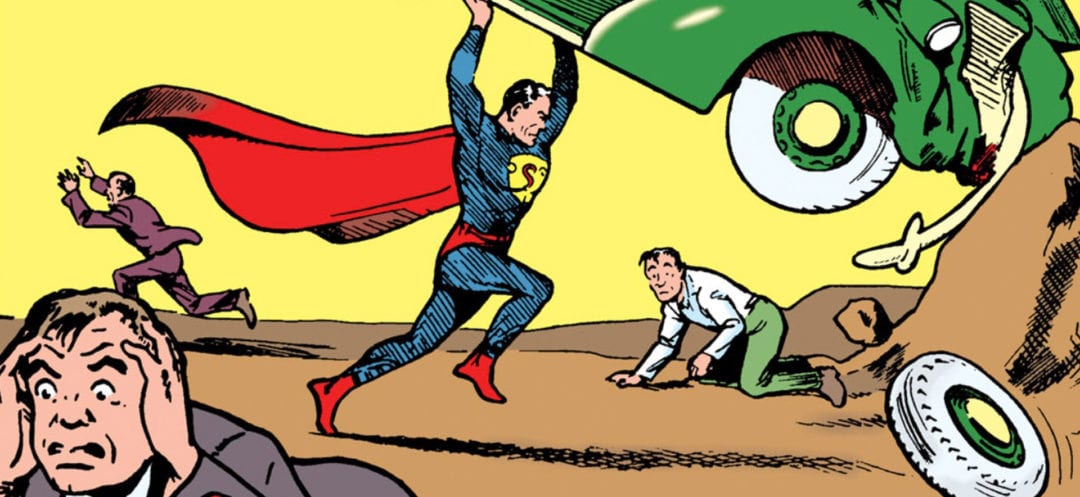
“HE’S NOT HUMAN! WHY BEING A BENEFIT TO MANKIND KILLED THE SUPERHEROES
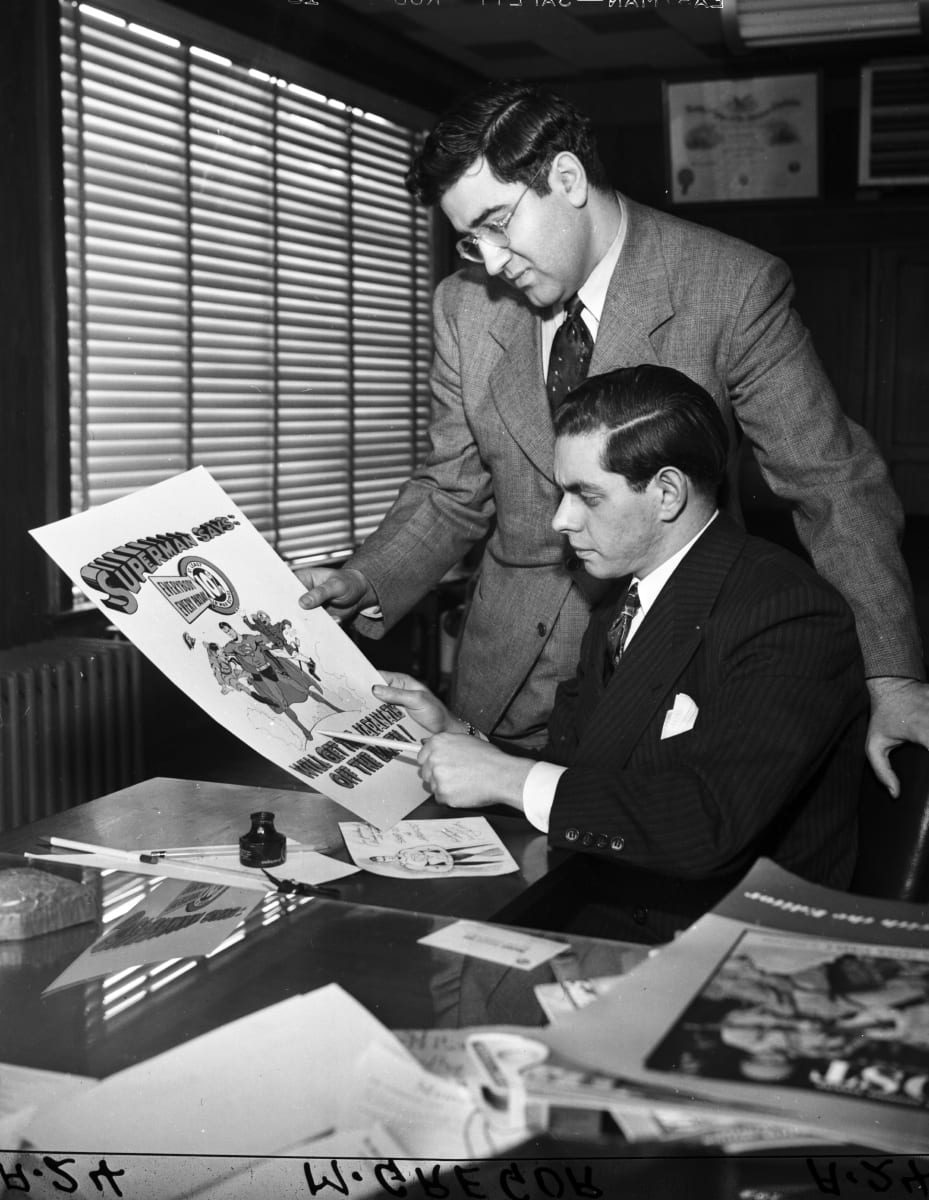 If you are interested in history of superhero comic books, and the men and women behind them, you are most likely familiar with the story I am about to tell you. It“s the story of the birth the superhero. In 1938, two young men from Cleveland finally saw the hero they had created on the printed page. They had dreamt up this character and his story a few years earlier, hoping they could sell him to a newspaper as syndicated comic-strip. This was where the money was, and the respect. Unlike in the very new comic book medium, creators of a newspaper strip that ran nation-wide could make a nice tidy sum and garner the adulation of their readers. Some of these creators were widely admired by the public. They became stars even. This seemed like the perfect dream to aspire to for these two young men, children of poor immigrants. With the right amount of luck and the right timing you could make it big. While they only received letters of rejections and were working hard to refine their character and his world, the creative duo got what to them must have felt like a consolation prize. They found work in the lesser medium, in comic books, when in 1935 they were offered a job at National Allied Publications, working on the “New Fun”“ series with which publisher Malcom Wheeler-Nicholson had created comics. Not as a collection of reprinted material from the newspaper strips, but as a vehicle for original content. Still they send in the story they had been working on since 1933. Most likely, while creating the first break-downs, they must have envisioned how the publishers and editors of the well-respected newspaper comic-strips would fall over each other in a mad dash to be the ones who would secure the rights, to be printing this series in their respective papers. But to the duos dismay, nothing came of it. Finally, after having established business relations with another comic book publisher, Detective Comics, Inc., the two creators accepted their defeat. They sold the rights to their character, who they had intended as a newspaper comic-strip hero, to this publisher of comics for just $130. Hardly the financial windfall they had hoped for. While Detective Comics, Inc. (the company would later merge with National Allied Publications and re-brand itself as DC Comics) retained the duo“s services for many years to come, even paying them handsomely (comparatively speaking), because their work was well liked by both the publisher and the readers, but surely foremost, because the series of stories with their creation at its center, became a huge hit and a financial boon for the publisher they had sold the rights to, these two creators would no longer receive the credit for their work. The two men, Jerry Siegel and Joe Shuster of course, who had dreamt up this character as a means to obtain fame and riches as newspaper comic-strip creators, were not only hired hands now, but found that their creation, not they themselves, would become famous and a star in his own right, an idea of a character so powerful that it not only changed pop culture, but culture itself.
If you are interested in history of superhero comic books, and the men and women behind them, you are most likely familiar with the story I am about to tell you. It“s the story of the birth the superhero. In 1938, two young men from Cleveland finally saw the hero they had created on the printed page. They had dreamt up this character and his story a few years earlier, hoping they could sell him to a newspaper as syndicated comic-strip. This was where the money was, and the respect. Unlike in the very new comic book medium, creators of a newspaper strip that ran nation-wide could make a nice tidy sum and garner the adulation of their readers. Some of these creators were widely admired by the public. They became stars even. This seemed like the perfect dream to aspire to for these two young men, children of poor immigrants. With the right amount of luck and the right timing you could make it big. While they only received letters of rejections and were working hard to refine their character and his world, the creative duo got what to them must have felt like a consolation prize. They found work in the lesser medium, in comic books, when in 1935 they were offered a job at National Allied Publications, working on the “New Fun”“ series with which publisher Malcom Wheeler-Nicholson had created comics. Not as a collection of reprinted material from the newspaper strips, but as a vehicle for original content. Still they send in the story they had been working on since 1933. Most likely, while creating the first break-downs, they must have envisioned how the publishers and editors of the well-respected newspaper comic-strips would fall over each other in a mad dash to be the ones who would secure the rights, to be printing this series in their respective papers. But to the duos dismay, nothing came of it. Finally, after having established business relations with another comic book publisher, Detective Comics, Inc., the two creators accepted their defeat. They sold the rights to their character, who they had intended as a newspaper comic-strip hero, to this publisher of comics for just $130. Hardly the financial windfall they had hoped for. While Detective Comics, Inc. (the company would later merge with National Allied Publications and re-brand itself as DC Comics) retained the duo“s services for many years to come, even paying them handsomely (comparatively speaking), because their work was well liked by both the publisher and the readers, but surely foremost, because the series of stories with their creation at its center, became a huge hit and a financial boon for the publisher they had sold the rights to, these two creators would no longer receive the credit for their work. The two men, Jerry Siegel and Joe Shuster of course, who had dreamt up this character as a means to obtain fame and riches as newspaper comic-strip creators, were not only hired hands now, but found that their creation, not they themselves, would become famous and a star in his own right, an idea of a character so powerful that it not only changed pop culture, but culture itself.
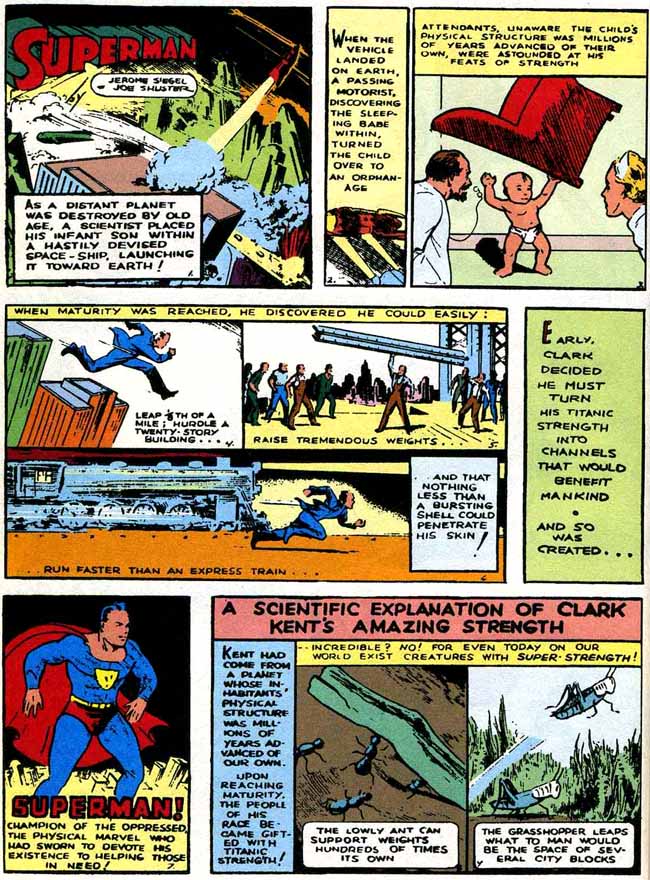 There is much speculation on what had originally inspired Jerry Siegel and Joe Shuster to come up with such a unique concept, the idea of a hero who possessed powers not seen in any type of fiction before. Their hero was no simple strong man. His powers were so vast, that one might mistake him for a villain on the cover of his first issue as he is shown holding up a car with ease while other men recoil from him in fear and awe. With his jet-black hair, clad in a blue bodysuit with red trunks, a yellow chest emblem, a red cape billowing in the wind almost horizontally while directing the readers eyes to a man, small in the background, fleeing in utter panic, Superman is raw power personified. His pose is as dynamic as it is threatening. The other two men, facing away from him to the reader, are utterly crushed, not in body, but in spirit, by the presence of such a super-being alone. One of the possible influences on Siegel and Shuster for the creation of Superman that gets cited regularly, is of course Hugo Danner. He was born with superpowers as well. Not unlike Siegel and Shuster“s character. His physique is not only that of a human body at its peak, but he is also endowed with superhuman strength and speed. His skin cannot be penetrated by a mere bullet. Hugo is the main character in Philip Wylie“s novel “Gladiator”“, published in 1930. The cover to the first edition of this science fiction novel can hardly contain Danner“s powerful, stretched body, that of a Greek god, towering in comparison to the silhouette of a modern city seen far in the background. There are no other characters depicted on the cover to this novel in which a scientist father, obsessed with unlocking the genetic potential of men, creates a super-serum to turn his unborn son into a super-being. Right there, already on the cover, you see the difference to Superman. Danner will spend the course of the novel not only hiding his superhuman abilities from the world at large, but he will hardly be seen using them. Not so with Superman. Just by looking at the cover for Action Comics No. 1, you get the idea behind Superman. Look, how he is able to lift a car over his head, with ease, and how he smashes it against a rock formation. Superman needs no car. He laughs at the idea and at your car. Like the bullies in school who beat you up, Superman was mocking his vanquished foes. This person was ostentatiously stronger than any bully. Nobody would push Superman around. And yet, with all his raw strength, he clearly was not an uber-bully who believed might makes right. Superman was the good guy. He looked out for the little people, those who had nobody who stood up for them. Philip Wylie, by all accounts, was highly accomplished. He had attended Princeton University, he wrote fiction and non-fiction, he was a scientist and a screenwriter. At one point in his life, he was the director of the Lerner Marine Laboratory, and he also served as an advisor to the chairman of what would become the Atomic Energy Commission. Jerry Siegel was unable to afford college. When he was eighteen years old, Siegel“s father was assaulted by a shoplifter in his store and died as a consequence of that attack. Like Shuster, Siegel was shy and bespectacled. Both were the sons of poor Jewish immigrants. While Wylie, who very much was the establishment, was moving in the right circles, establishing contacts that would offer him opportunities to advance his career in different directions, Siegel and Shuster loved science fiction and adventure fiction. They both were nerds and outsiders. Together they would create the first superhero.
There is much speculation on what had originally inspired Jerry Siegel and Joe Shuster to come up with such a unique concept, the idea of a hero who possessed powers not seen in any type of fiction before. Their hero was no simple strong man. His powers were so vast, that one might mistake him for a villain on the cover of his first issue as he is shown holding up a car with ease while other men recoil from him in fear and awe. With his jet-black hair, clad in a blue bodysuit with red trunks, a yellow chest emblem, a red cape billowing in the wind almost horizontally while directing the readers eyes to a man, small in the background, fleeing in utter panic, Superman is raw power personified. His pose is as dynamic as it is threatening. The other two men, facing away from him to the reader, are utterly crushed, not in body, but in spirit, by the presence of such a super-being alone. One of the possible influences on Siegel and Shuster for the creation of Superman that gets cited regularly, is of course Hugo Danner. He was born with superpowers as well. Not unlike Siegel and Shuster“s character. His physique is not only that of a human body at its peak, but he is also endowed with superhuman strength and speed. His skin cannot be penetrated by a mere bullet. Hugo is the main character in Philip Wylie“s novel “Gladiator”“, published in 1930. The cover to the first edition of this science fiction novel can hardly contain Danner“s powerful, stretched body, that of a Greek god, towering in comparison to the silhouette of a modern city seen far in the background. There are no other characters depicted on the cover to this novel in which a scientist father, obsessed with unlocking the genetic potential of men, creates a super-serum to turn his unborn son into a super-being. Right there, already on the cover, you see the difference to Superman. Danner will spend the course of the novel not only hiding his superhuman abilities from the world at large, but he will hardly be seen using them. Not so with Superman. Just by looking at the cover for Action Comics No. 1, you get the idea behind Superman. Look, how he is able to lift a car over his head, with ease, and how he smashes it against a rock formation. Superman needs no car. He laughs at the idea and at your car. Like the bullies in school who beat you up, Superman was mocking his vanquished foes. This person was ostentatiously stronger than any bully. Nobody would push Superman around. And yet, with all his raw strength, he clearly was not an uber-bully who believed might makes right. Superman was the good guy. He looked out for the little people, those who had nobody who stood up for them. Philip Wylie, by all accounts, was highly accomplished. He had attended Princeton University, he wrote fiction and non-fiction, he was a scientist and a screenwriter. At one point in his life, he was the director of the Lerner Marine Laboratory, and he also served as an advisor to the chairman of what would become the Atomic Energy Commission. Jerry Siegel was unable to afford college. When he was eighteen years old, Siegel“s father was assaulted by a shoplifter in his store and died as a consequence of that attack. Like Shuster, Siegel was shy and bespectacled. Both were the sons of poor Jewish immigrants. While Wylie, who very much was the establishment, was moving in the right circles, establishing contacts that would offer him opportunities to advance his career in different directions, Siegel and Shuster loved science fiction and adventure fiction. They both were nerds and outsiders. Together they would create the first superhero.
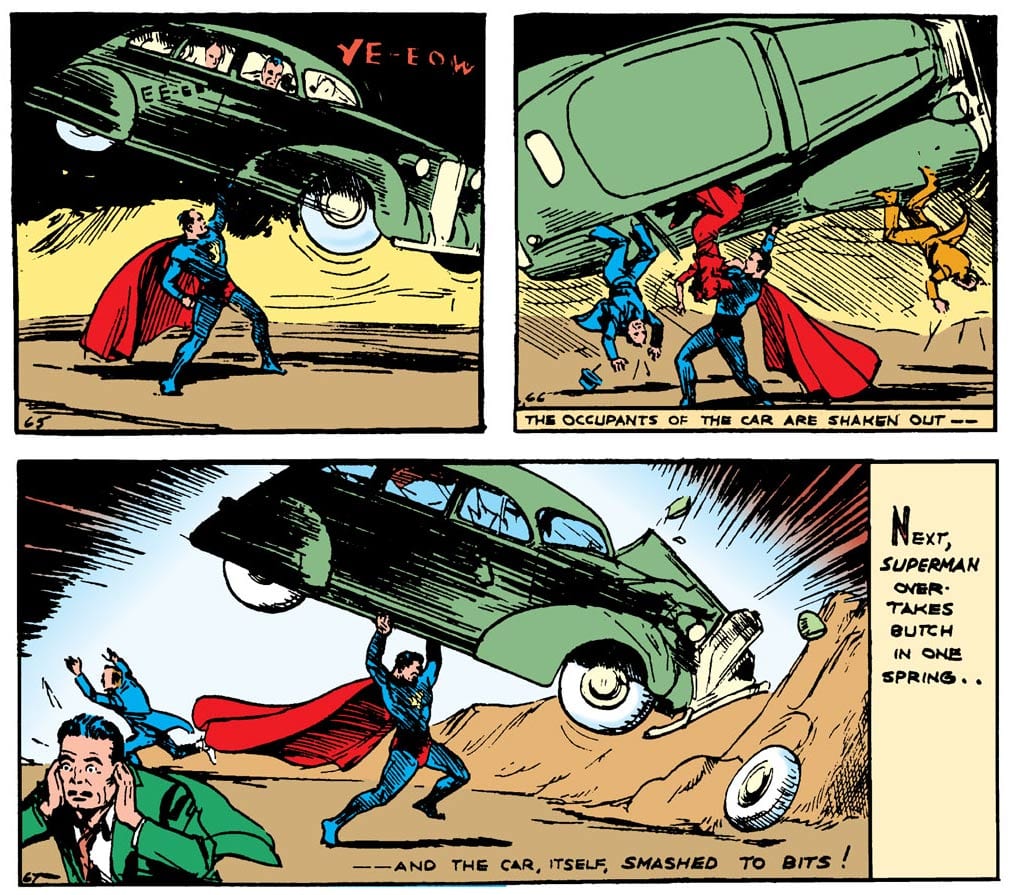 Superman would prove to be Siegel and Shuster“s most successful creation. A success they found they were unable to recreate. Not so the superheroes. Due to the immense popularity of this one character, soon many comic book publishers rushed their own superheroes and superheroines out the door. But why did Superman catch on so quickly with readers? Why was he the model others would follow? Why was the idea of a Superman such a powerful one and so potent? The first Superheroes pre-date World War II (especially if you consider that there were superhero-like characters in the pulp magazines), but the rise of comic books coincided with the war, so much so, that even prior to America“s involvement in the war, the first issue of Captain America Comics would famously feature this new superhero, who was almost literally wearing the American flag as his costume, punching Adolf Hitler in the face. Comics could be daring, and this only made them more popular, especially those with a patriotic bend. Soldiers would be carrying Superman and Captain America comics in their backpacks soon. And there were radio shows, movie serials, cartoons and tons of products with the superheroes“ faces on them. Comics, like any type of art, should be reflective of their time. And in the 1940s, they all but became about what we nowadays call jingoism and what back then, simply was referred to as patriotism. These Superheroes allowed readers to see the good guys win all the time. And they could do what seemingly nobody else was able to do. They could punch the dictator of a foreign nation right in the face. You can see seeds of this in Superman. But Superman did much more than just to show some bad guys who was boss. Going back to the cover of Action Comics No. 1, and even more so if you flip through the first couple of pages, you could be forgiven very easily if you thought that this guy in the blue bodysuit with the red cape was the villain of the story. After an introductory page (after the advertisement on the back of the cover of course), which you might as easily skip at first, because let“s be honest, you want to get right into the action, you may think there are a couple of pages missing. This new character, as shown on the cover, is seen leaping through the air with a blonde woman in his muscular arms, a woman bound and gagged no less. In the second panel, this stranger leaves the bound woman leaned against a tree. While dashing towards a nearby house, he quips a cool one-liner like many action stars would more than four decades into the future: “Make yourself comfortable!”“ Superman, upon knocking on the door to the house, is met by a butler whom he tells: “I must see the governor, it“s a matter of life and death!”“ The butler will have none of this, since it is late at night, and thus shuts the door right in the face of this stranger. But he won“t be denied and just breaks down the door. In the sequence of the next couple of panels we see Superman confronting the servant, lifting him with one arm into the air, while further forcing entrance into what is clearly a private residence. Apparently, governors sleep behind steel doors. This one does in any case. With a smirk in his face, the servant mocks the stranger “Try and knock this door down!”“ It is of course exactly what the guy in the blue outfit does. Striking what will become known as the “hero pose”“, Superman once again quips. “It was your idea!”“ Once in the bedroom of the governor, Superman explains what this is all about. A woman is about to be executed for a crime she is innocent of. He has written proof. With the execution scheduled in 15 minutes, Superman needs the governor to make an urgent phone call to stop this from happening. At this point in the story, the governor“s servant pulls a gun, thinking this stranger mad. After giving him fair warning, he fires. But the bullet has no effect. At this point we see a clock in two consecutive panels, very small, put ticking very fast. This is to increase tension of course, but also increases the dynamic flow of the story. Every second counts, dear reader. We are literally minutes away from an innocent person dying. At this point, the governor relents. After checking a note handed to him by the stranger, he makes the phone call to the penitentiary that spares the woman“s life, who is seen in one panel only, kneeling in front of a priest, the electric chair taking up most of the panel. By then, Superman is long gone. But he has left another note which explains that the real killer can be found outside the governor“s house. The bound and gagged woman we assume. Then we get two panels with Clark Kent, a very ordinary looking guy in a suit, wearing a hat and glasses. Clark works as a reporter for one of the big newspapers. Clark Kent, Superman“s civilian identity, is mentioned on the introductory page, so we know this is our guy. But the final panel belongs to the governor talking to several important looking men in a boardroom. He has this to say: “He“s not human! ”“ Thank heaven he“s apparently on the side of law and order!”“ Siegel and Shuster tell you this story in just three pages.
Superman would prove to be Siegel and Shuster“s most successful creation. A success they found they were unable to recreate. Not so the superheroes. Due to the immense popularity of this one character, soon many comic book publishers rushed their own superheroes and superheroines out the door. But why did Superman catch on so quickly with readers? Why was he the model others would follow? Why was the idea of a Superman such a powerful one and so potent? The first Superheroes pre-date World War II (especially if you consider that there were superhero-like characters in the pulp magazines), but the rise of comic books coincided with the war, so much so, that even prior to America“s involvement in the war, the first issue of Captain America Comics would famously feature this new superhero, who was almost literally wearing the American flag as his costume, punching Adolf Hitler in the face. Comics could be daring, and this only made them more popular, especially those with a patriotic bend. Soldiers would be carrying Superman and Captain America comics in their backpacks soon. And there were radio shows, movie serials, cartoons and tons of products with the superheroes“ faces on them. Comics, like any type of art, should be reflective of their time. And in the 1940s, they all but became about what we nowadays call jingoism and what back then, simply was referred to as patriotism. These Superheroes allowed readers to see the good guys win all the time. And they could do what seemingly nobody else was able to do. They could punch the dictator of a foreign nation right in the face. You can see seeds of this in Superman. But Superman did much more than just to show some bad guys who was boss. Going back to the cover of Action Comics No. 1, and even more so if you flip through the first couple of pages, you could be forgiven very easily if you thought that this guy in the blue bodysuit with the red cape was the villain of the story. After an introductory page (after the advertisement on the back of the cover of course), which you might as easily skip at first, because let“s be honest, you want to get right into the action, you may think there are a couple of pages missing. This new character, as shown on the cover, is seen leaping through the air with a blonde woman in his muscular arms, a woman bound and gagged no less. In the second panel, this stranger leaves the bound woman leaned against a tree. While dashing towards a nearby house, he quips a cool one-liner like many action stars would more than four decades into the future: “Make yourself comfortable!”“ Superman, upon knocking on the door to the house, is met by a butler whom he tells: “I must see the governor, it“s a matter of life and death!”“ The butler will have none of this, since it is late at night, and thus shuts the door right in the face of this stranger. But he won“t be denied and just breaks down the door. In the sequence of the next couple of panels we see Superman confronting the servant, lifting him with one arm into the air, while further forcing entrance into what is clearly a private residence. Apparently, governors sleep behind steel doors. This one does in any case. With a smirk in his face, the servant mocks the stranger “Try and knock this door down!”“ It is of course exactly what the guy in the blue outfit does. Striking what will become known as the “hero pose”“, Superman once again quips. “It was your idea!”“ Once in the bedroom of the governor, Superman explains what this is all about. A woman is about to be executed for a crime she is innocent of. He has written proof. With the execution scheduled in 15 minutes, Superman needs the governor to make an urgent phone call to stop this from happening. At this point in the story, the governor“s servant pulls a gun, thinking this stranger mad. After giving him fair warning, he fires. But the bullet has no effect. At this point we see a clock in two consecutive panels, very small, put ticking very fast. This is to increase tension of course, but also increases the dynamic flow of the story. Every second counts, dear reader. We are literally minutes away from an innocent person dying. At this point, the governor relents. After checking a note handed to him by the stranger, he makes the phone call to the penitentiary that spares the woman“s life, who is seen in one panel only, kneeling in front of a priest, the electric chair taking up most of the panel. By then, Superman is long gone. But he has left another note which explains that the real killer can be found outside the governor“s house. The bound and gagged woman we assume. Then we get two panels with Clark Kent, a very ordinary looking guy in a suit, wearing a hat and glasses. Clark works as a reporter for one of the big newspapers. Clark Kent, Superman“s civilian identity, is mentioned on the introductory page, so we know this is our guy. But the final panel belongs to the governor talking to several important looking men in a boardroom. He has this to say: “He“s not human! ”“ Thank heaven he“s apparently on the side of law and order!”“ Siegel and Shuster tell you this story in just three pages.
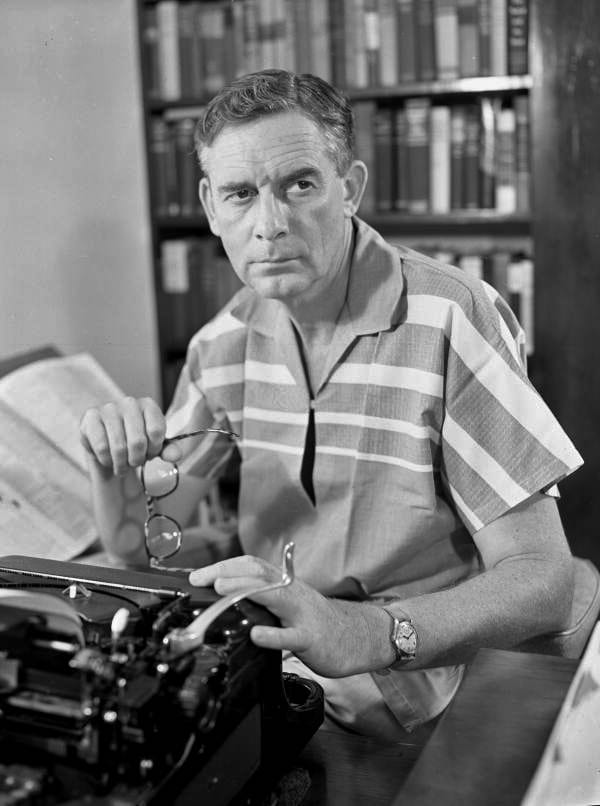 After yet another mission in which Superman demolishes a wife-beater, we are introduced to Lois Lane. In just one panel with very little dialogue, we get this: Lois works at the same paper, Clark asks Lois for a date. This is not the first time. Lois says yes, for the first time. While dancing with her at a nightclub, some sleazy a guy wants to cut in. Clark takes the route of the coward apparently, telling Lois, why not dance with the guy, it is the reasonable thing to do to avoid further conflict. But Lois will have none of it and slaps the guy right in the face. Of course, the guy gets pretty aggressive, but not with Lois. Clark is the man in the room and he gets challenged. But of course, Clark refuses and Lois leaves. What Siegel and Shuster set up here, right in the first issue of Superman, will play out over and over again. Including the rescue of Lois by Superman after Mr. Nice Guy and his two friends abduct Lois. This would not just become a staple in many Superman stories, but a blueprint for any such type of story to come. The guy in the tights and cape would be hero, but his alter ego was no fighter. He was one of the masses, mostly. But whenever he was in his hero identity, his fight would be for the common good. Never for personal gain. Even Detective Comic, Inc.“s next superhero, The Batman, who would make his debut less than a year later, was fighting all criminals, not just the killer of his parents specifically. Interestingly, his origin would not even be told in the issue in which he made his very first appearance. Other than just creating a whole new genre and very economically setting up the character and his world in a few pages, Siegel and Shuster gave the first superhero a clear mission. Not a motivation that, at that point in time, had come from the character of Superman or Clark Kent, but a mission. As stated on the first introductory page, Superman was “The Champion of the Oppressed”“. And as such, Superman acted outside the law.
After yet another mission in which Superman demolishes a wife-beater, we are introduced to Lois Lane. In just one panel with very little dialogue, we get this: Lois works at the same paper, Clark asks Lois for a date. This is not the first time. Lois says yes, for the first time. While dancing with her at a nightclub, some sleazy a guy wants to cut in. Clark takes the route of the coward apparently, telling Lois, why not dance with the guy, it is the reasonable thing to do to avoid further conflict. But Lois will have none of it and slaps the guy right in the face. Of course, the guy gets pretty aggressive, but not with Lois. Clark is the man in the room and he gets challenged. But of course, Clark refuses and Lois leaves. What Siegel and Shuster set up here, right in the first issue of Superman, will play out over and over again. Including the rescue of Lois by Superman after Mr. Nice Guy and his two friends abduct Lois. This would not just become a staple in many Superman stories, but a blueprint for any such type of story to come. The guy in the tights and cape would be hero, but his alter ego was no fighter. He was one of the masses, mostly. But whenever he was in his hero identity, his fight would be for the common good. Never for personal gain. Even Detective Comic, Inc.“s next superhero, The Batman, who would make his debut less than a year later, was fighting all criminals, not just the killer of his parents specifically. Interestingly, his origin would not even be told in the issue in which he made his very first appearance. Other than just creating a whole new genre and very economically setting up the character and his world in a few pages, Siegel and Shuster gave the first superhero a clear mission. Not a motivation that, at that point in time, had come from the character of Superman or Clark Kent, but a mission. As stated on the first introductory page, Superman was “The Champion of the Oppressed”“. And as such, Superman acted outside the law.
As Siegel and Shuster tell it in the first three story pages of Action Comics No.1, their hero has little to no regard for following a protocol or due process. The real murderess is first seen bound and gagged. He has already obtained her written confession. Then he shows abusive behavior towards the butler of the governor while forcefully entering the elected state official“s residence, destroying two locked doors and not even stopping at gunpoint. Later, when he confronts the husband who is beating his wife, there is no attempt on Superman“s part to talk to the man or to simply stop him by rendering him unconscious with a slight tap. Instead Superman lifts him up in the air like the manservant and then he smashes him back first into a wall with so much force that the plaster starts flying through the air while proclaiming: “You are not fighting a woman, now!”“ Once again, just looking at this one panel in isolation, we might be unsure who the hero of this story is. Why should we assume it is the man in the blue suit and cape?  Are these not the actions of a bully? A law-breaker even? But of course, we are not looking at just one panel, we are reading a story. We are looking at sequential art, to be precise. Superman“s creators knew full well that in order to bring the point across, that he was the hero of this story, and not only the hero, but the world“s first superhero, they had to tell you this. We don“t learn this by reading the story itself. We are told right on the introductory page: “Early Clark decided he must turn his titanic strength into channels that would benefit mankind. And so was created”¦ Superman!”“ The point is reinforced by the words of the governor, who is sure that Superman is not human, but “apparently on the side of law and order!”“. Which seems strange given the series of events he himself witnessed during the night. But we don“t hear a character talking here, but the creators themselves. For justice, there must be a Superman.
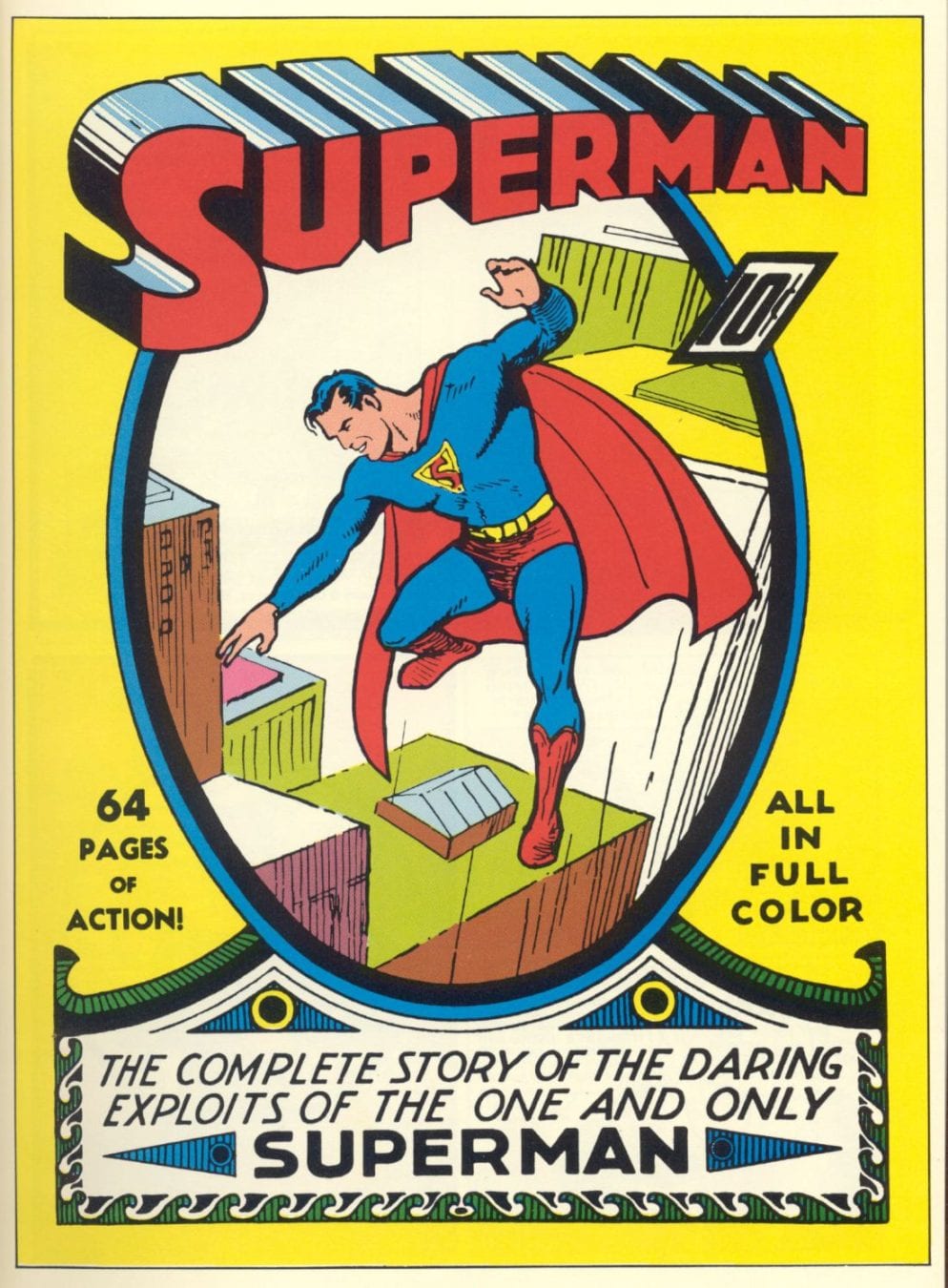 Superman“s creators were not part of the system like Philip Wylie, whose hero possessed similar powers than Superman, powers that made him an outsider by design, while he very much wanted to be part of society and thus did not show his abilities to the world. Siegel and Shuster were very much outside the system. Even more so, the system had failed them. Like Superman, they showed little concern for what the system believed was the right thing to do. It was up to the individual to make things right. The first superhero was born out of the idea that the individual is not only charged with a call for the betterment of society, but the conviction, that this was his personal responsibility. Superman would show the way. He would lead. Others would follow. Heroes, and creators who would shape them based on this ideal. Â Their heroes and heroines might work with the police of their hometown on occasion, but they all had secret identities and they very much worked outside the law. They all had the same mission and they did what felt right to them (which was exactly what every other superhero did). They needed no further motivation that was based in their character, something that made them unique. There was no personal struggle, no conflict. No temptations along the way. Because there was no way to speak of. They fought the bad guys. They knew how to use their powers. Right from the start. There was no learning curve, no hero“s journey. Superheroes instinctively knew what the right thing to do was. To use superpowers for the common good. For mankind. You were supposed to. Superman was the first to do so and he was not even human. He was after all the Champion of the Oppressed. Because Siegel and Shuster told you so. On the first page of Action Comics No. 1. This however takes away from the individual“s (in fiction, the main character“s) right to choose his or her own path. If everyone strives for the same ideal, there is no personal investment, nothing will be unique about a person“s objective, there is no struggle since there is no room for conflict. It is very often said, that superheroes, for the most part, fell out of favor in the mid-1940s, because once the war had ended, there were no more villains to fight. I would argue, superhero and superheroines lost their readers“ interest because culture itself shifted away from them. Siegel and Shuster created a hero who helped the oppressed. They felt they were the oppressed. That the system was not working for them. That it did not look out for them. Once there were more heroes and the pre-war times patriotism settled in, “to benefit mankind”“ (in this case, every citizen of the free world) became the oft-repeated mantra. There were exceptions. Plastic Man or the original Daredevil (created by Jack Binder, revamped by Plastic Man“s creator Jack Cole and made into a somewhat more rounded character by Charles Biro). Daredevil had fun (funny) sidekicks of whom one was killed off. One daring move for that time (1942). By and large, this only underlined the idea, that a superhero would experience loss, but that this only made him (or her) more determined. And so, eventually, like so many other heroes, Daredevil would be replaced (in his case by his own gang of sidekicks), because readers no longer were interested in this type of characters or their stories. This culture change achieved what no evil dictator or supervillain had been able to it. It killed the superheroes. Most of them. Those who managed to hold on, among them the superhero who had started them all on this road, Superman, did so, because other creators found different stories to tell with them, stories on a much more personal, smaller stage. They no longer had to benefit mankind, but they all became your father or big brother. Superman would not be breaking down doors anymore to save an innocent soul, but he settled in with his adopted family in Metropolis. And Batman with his. The Atomic Age had begun. The personal age.
Superman“s creators were not part of the system like Philip Wylie, whose hero possessed similar powers than Superman, powers that made him an outsider by design, while he very much wanted to be part of society and thus did not show his abilities to the world. Siegel and Shuster were very much outside the system. Even more so, the system had failed them. Like Superman, they showed little concern for what the system believed was the right thing to do. It was up to the individual to make things right. The first superhero was born out of the idea that the individual is not only charged with a call for the betterment of society, but the conviction, that this was his personal responsibility. Superman would show the way. He would lead. Others would follow. Heroes, and creators who would shape them based on this ideal. Â Their heroes and heroines might work with the police of their hometown on occasion, but they all had secret identities and they very much worked outside the law. They all had the same mission and they did what felt right to them (which was exactly what every other superhero did). They needed no further motivation that was based in their character, something that made them unique. There was no personal struggle, no conflict. No temptations along the way. Because there was no way to speak of. They fought the bad guys. They knew how to use their powers. Right from the start. There was no learning curve, no hero“s journey. Superheroes instinctively knew what the right thing to do was. To use superpowers for the common good. For mankind. You were supposed to. Superman was the first to do so and he was not even human. He was after all the Champion of the Oppressed. Because Siegel and Shuster told you so. On the first page of Action Comics No. 1. This however takes away from the individual“s (in fiction, the main character“s) right to choose his or her own path. If everyone strives for the same ideal, there is no personal investment, nothing will be unique about a person“s objective, there is no struggle since there is no room for conflict. It is very often said, that superheroes, for the most part, fell out of favor in the mid-1940s, because once the war had ended, there were no more villains to fight. I would argue, superhero and superheroines lost their readers“ interest because culture itself shifted away from them. Siegel and Shuster created a hero who helped the oppressed. They felt they were the oppressed. That the system was not working for them. That it did not look out for them. Once there were more heroes and the pre-war times patriotism settled in, “to benefit mankind”“ (in this case, every citizen of the free world) became the oft-repeated mantra. There were exceptions. Plastic Man or the original Daredevil (created by Jack Binder, revamped by Plastic Man“s creator Jack Cole and made into a somewhat more rounded character by Charles Biro). Daredevil had fun (funny) sidekicks of whom one was killed off. One daring move for that time (1942). By and large, this only underlined the idea, that a superhero would experience loss, but that this only made him (or her) more determined. And so, eventually, like so many other heroes, Daredevil would be replaced (in his case by his own gang of sidekicks), because readers no longer were interested in this type of characters or their stories. This culture change achieved what no evil dictator or supervillain had been able to it. It killed the superheroes. Most of them. Those who managed to hold on, among them the superhero who had started them all on this road, Superman, did so, because other creators found different stories to tell with them, stories on a much more personal, smaller stage. They no longer had to benefit mankind, but they all became your father or big brother. Superman would not be breaking down doors anymore to save an innocent soul, but he settled in with his adopted family in Metropolis. And Batman with his. The Atomic Age had begun. The personal age.
Author Profile
- A comic book reader since 1972. When he is not reading or writing about the books he loves or is listening to The Twilight Sad, you can find Chris at his consulting company in Germany... drinking damn good coffee. Also a proud member of the ICC (International Comics Collective) Podcast with Al Mega and Dave Elliott.
Latest entries
 ColumnsDecember 30, 2020“FORGET THE NIGHT AHEAD” – WITHOUT FEAR, PART 1
ColumnsDecember 30, 2020“FORGET THE NIGHT AHEAD” – WITHOUT FEAR, PART 1 ColumnsDecember 16, 2020“I WANT TO BELIEVE” – THE CHILDREN OF THE NIGHT, PART 5
ColumnsDecember 16, 2020“I WANT TO BELIEVE” – THE CHILDREN OF THE NIGHT, PART 5 ColumnsNovember 25, 2020“HE STILL INSISTS HE SEES THE GHOSTS“ THE CHILDREN OF THE NIGHT, PART 4
ColumnsNovember 25, 2020“HE STILL INSISTS HE SEES THE GHOSTS“ THE CHILDREN OF THE NIGHT, PART 4 ColumnsNovember 11, 2020“WHATEVER WALKED THERE, WALKED ALONE” THE CHILDREN OF THE NIGHT, PART 3
ColumnsNovember 11, 2020“WHATEVER WALKED THERE, WALKED ALONE” THE CHILDREN OF THE NIGHT, PART 3







